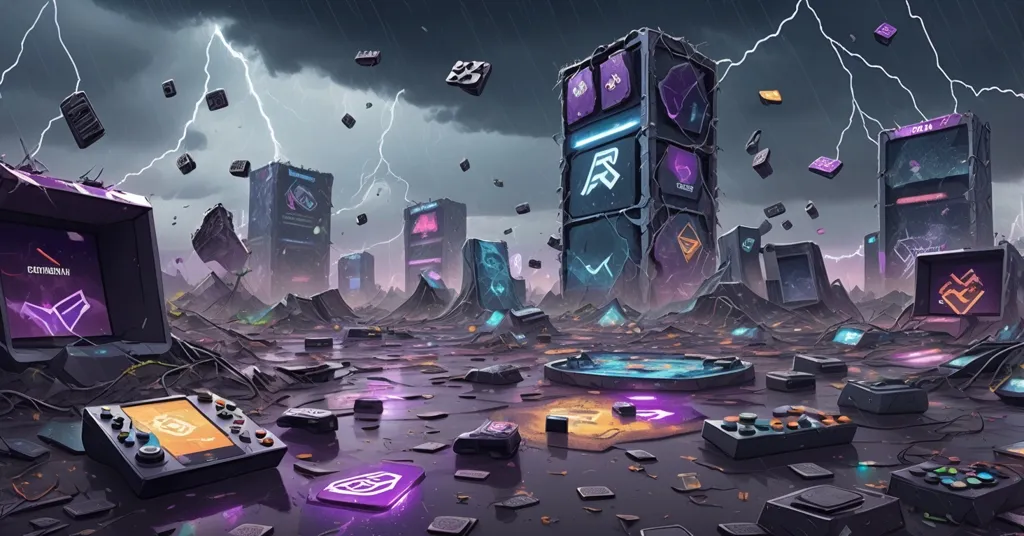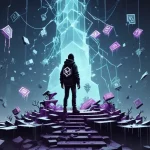Web3 Gaming Crisis 2025: User Drop, Failures, and Big Brands’ Blockchain Bet

Web3 Gaming Struggles in 2025: Big Brands and Blockchain Hope Persist
Web3 gaming is navigating a brutal storm in Q2 2025, with daily user activity plummeting 17%, over 300 decentralized gaming apps going dark, and funding hitting a two-year low of $73 million. Yet, amidst the wreckage, traditional gaming giants like Sega, Ubisoft, and FIFA stand firm in their blockchain ambitions, while a handful of projects and infrastructure investments signal a stubborn, if shaky, path toward recovery.
- User Activity Crash: Daily active users dropped to 4.8 million, a 17% decline and the lowest since early 2023.
- Project Failures: Over 300 gaming dApps are inactive, with many shutting down due to funding shortages and flawed tokenomics.
- Persistent Hope: Big brands remain committed, infrastructure funding dominates, and titles like “Off the Grid” show promise.
The Collapse of Play-to-Earn Hype
The web3 gaming sector, once heralded as a revolutionary fusion of blockchain and play, is in dire straits. In Q2 2025, daily unique active wallets—a measure of user engagement—tumbled by 17% to just 4.8 million, a low not seen since the early days of 2023. Investment has dried up spectacularly, with only $73 million raised, marking a staggering 93% plunge from the same period last year. To put this into perspective, while Bitcoin weathered a modest 5% dip, other crypto sectors fared far worse: AI frameworks cratered 84%, agent-based projects lost 70%, memecoins shed 51%, and gaming infrastructure itself dropped over 50%. Even major blockchain platforms like Ethereum and Solana took hits of around 25% each. It’s a bloodbath across the board, but web3 gaming seems to be bleeding out faster than most, as highlighted in recent industry reports on gaming struggles.
Behind these grim numbers lies a deeper issue: the unsustainable models that fueled the 2021-2022 play-to-earn (P2E) boom. P2E games promised players real-world earnings through tokens and NFTs—unique digital assets on the blockchain representing in-game items or ownership rights. Think of NFTs as digital deeds; they’re supposed to give players true control over their virtual loot. But many of these games were less about fun and more about financial speculation. Clunky mechanics, grind-heavy gameplay, and economies built on quick cash-outs led to inevitable crashes. When players dumped their tokens for profit, values tanked, leaving projects like Ember Sword and Nyan Heroes in ruins. Ember Sword, for instance, saw its token issuance outpace player demand by a reported 300%, resulting in a 90% value collapse within six months. As Sara Gherghelas, a blockchain analyst at DappRadar, put it with unflinching clarity:
“Dozens of Web3 games shut down, funding continued its decline, and user activity dipped across the board. From overhyped MMORPGs to play-to-earn battlers, many titles simply couldn’t survive the harsh market conditions, whether due to dried-up investor backing, poor retention, or unsustainable tokenomics.”
Tokenomics, for those new to the space, is the economic blueprint of a project’s cryptocurrency—how tokens are created, distributed, and used. When poorly designed, as in many early P2E titles, it’s like a small town printing endless local money; everyone feels rich until they try to spend it, and the value implodes. This vicious cycle, combined with a broader crypto market downturn where investors flock to Bitcoin’s relative safety, has left over 300 gaming dApps—decentralized applications running on blockchain—completely inactive. Some, like Mojo Melee and backers of Realms of Alurya such as Treasure DAO, didn’t just pivot; they abandoned gaming altogether for trendy AI ventures like movie creation platforms. It’s a desperate move, chasing the next shiny object as the gaming promise fades, a trend further explored in detailed market analysis on user activity declines.
Why Are Crypto Games Failing So Hard?
Let’s not sugarcoat it: many web3 games were digital slot machines masquerading as RPGs, and players finally pulled the plug. The core issue is a misalignment of priorities. Developers hyped financial rewards over engaging gameplay, alienating both crypto-native users who value ownership and mainstream gamers who just want a good time. Imagine a gamer sinking hours into a P2E title, lured by promises of earning $100 a month, only to find the token worthless after a mass sell-off. That’s the story of Nyan Heroes, where token devaluation and lack of funding forced a shutdown despite early buzz. Add to that the complexity of crypto—setting up wallets, understanding gas fees (transaction costs on blockchains like Ethereum), and navigating NFT marketplaces—and it’s no wonder retention is abysmal, a sentiment echoed in community discussions on why web3 gaming struggles persist.
Market conditions haven’t helped. With venture capital drying up amid a broader crypto winter, developers lack the runway to iterate or polish their products. Investors, burned by speculative bubbles of yesteryear, are hesitant to back unproven models, especially when Bitcoin offers a less volatile haven. Then there’s the regulatory shadow looming large. In jurisdictions like the United States, the SEC has eyed gaming tokens as potential unregistered securities, a classification that could slap developers with costly compliance requirements or outright bans. If a token reward for slaying a virtual dragon is deemed gambling or an investment contract, the legal headaches could kill innovation before it even starts. This uncertainty keeps both developers and players on edge, as debated in forums like why blockchain projects often falter.
Infrastructure: Betting on the Future, Not the Present
While game designs flounder, the industry is redirecting its scant resources to build stronger foundations. Of the $73 million raised in Q2, a hefty 75% went to infrastructure rather than direct game development. Projects like Ultra, which secured $12 million for a blockchain-based publishing platform, MagicBlock with $7.5 million for a real-time gaming engine on Solana, and Cooking.City’s $7 million for a token-rewarded culinary game, highlight this shift. These aren’t sexy, hype-driven bets; they’re nuts-and-bolts investments in the tools and pipes needed for web3 gaming to mature. Think of it as rebuilding the highway system while the cars keep breaking down—it’s not glamorous, but it’s necessary, a perspective aligned with broader trends in blockchain gaming for 2025.
Certain blockchain networks are also stepping up amid the chaos. opBNB, a layer-2 solution on BNB Chain designed for high-speed, low-cost transactions, leads in active wallets, showing strong user engagement for gaming dApps. WAX dominates transaction volume, while newer chains like Aptos, Sei, and SKALE are attracting increased gaming traffic due to their scalability and cost efficiency. These platforms offer developers a lifeline—lower fees and faster processing mean more room to experiment without bleeding cash. But let’s play devil’s advocate: betting on infrastructure is a long game, and who’s playing today if no compelling titles emerge? Without standout games to draw users, even the best highways risk becoming ghost roads.
Bright Spots in a Dark Landscape
Amid the carnage, there are flickers of hope. Take “Off the Grid,” a battle royale title running on Avalanche’s custom GUNZ subnet—a specialized blockchain layer tailored for gaming needs. Even in its testing phase, it’s gaining serious traction, blending high-octane gameplay with blockchain perks like NFT ownership and potential token rewards. Unlike many P2E flops, it seems to prioritize fun first; early feedback suggests players are hooked on the mechanics, not just the financial carrot. It’s a rare blueprint for balancing entertainment with decentralization’s promise of true digital ownership—a middle finger to centralized gaming empires if it can scale, as seen in reviews of Off the Grid’s performance.
Metaverse projects, often tied to gaming, show mixed but intriguing signals. While NFT trading volume for virtual worlds dropped 26%, sales spiked 54%, hinting at more activity at lower prices. Moves by Yuga Labs to open access to Otherside, Animoca building Mocaverse as a Layer 1 blockchain, Pixels spinning off mobile experiences, and The Sandbox partnering with Cirque du Soleil for large-scale events suggest innovation persists in adjacent spaces. These efforts tie into gaming by exploring virtual identity and economies, potentially paving the way for richer player-driven worlds. But can they reignite broader interest, or are they just niche experiments? For a deeper understanding of the underlying tech, check out this overview of Web3 concepts.
Big Brands Double Down on Blockchain
Here’s where it gets interesting: despite the mess, traditional gaming titans aren’t bailing. Sega, Ubisoft, and FIFA are diving headfirst into the crypto swamp, betting on blockchain to redefine digital ownership, player economies, and—let’s be real—new revenue streams via NFTs or tokenized microtransactions. Their involvement lends credibility to a space often written off as a scam-riddled Wild West. Robbie Ferguson, co-founder of Immutable, a leading blockchain gaming platform, offered a glimpse of optimism on this front:
Implied optimism about 2025 compressing years of development, with major gaming companies worth over $1 billion becoming open to launching tokens, indicating a shift toward higher-quality blockchain games and useful token economies.
Ferguson’s vision is tantalizing—billion-dollar studios crafting titles where tokens aren’t speculative trash but tools for in-game governance or asset trading. It’s a far cry from the Ponzi-like disasters of early P2E games, a shift noted in recent news on Immutable and major company involvement. But let’s not drink the Kool-Aid just yet. Are Sega and Ubisoft truly committed, or just trend-chasing, ready to bolt if profits don’t materialize? And even if they stay, regulatory roadblocks and gamer skepticism—many still recoil at the NFT stigma—could stall this grand vision. Mainstream players aren’t clamoring for crypto complexity; they want immersive experiences, not wallet tutorials.
Bitcoin’s Anchor and Altcoin Niches
As a Bitcoin maximalist at heart, I can’t help but note BTC’s role in this storm. While web3 gaming flails with infrastructure losses over 50%, Bitcoin’s mere 5% dip stands as a beacon of resilience. It’s a reminder that decentralization’s core must prioritize stability over speculative hype. Investors fleeing to BTC amid this chaos reinforce its status as crypto’s unshakeable bedrock. Yet, altcoin ecosystems like Avalanche with its GUNZ subnet, Solana powering real-time engines, and others are carving out vital niches in gaming’s future. Bitcoin doesn’t need to solve every problem—it’s the foundation, not the furniture. These altchains fill gaps BTC shouldn’t, proving the broader blockchain space’s strength lies in diverse innovation.
Key Takeaways and Questions on Web3 Gaming’s Future
- What’s the true state of web3 gaming in 2025?
It’s in rough shape, with daily users down 17% to 4.8 million, funding at a two-year low of $73 million, and over 300 dApps inactive or shuttered. - Why are so many blockchain games failing?
Unsustainable tokenomics, poor gameplay, funding shortages, and harsh market conditions are killing projects like Ember Sword and Nyan Heroes, compounded by regulatory uncertainty, with insights into these failures available in case studies on play-to-earn model issues. - Are there any signs of recovery or potential?
Yes, titles like “Off the Grid” on Avalanche shine, blockchains like opBNB and WAX gain traction, and infrastructure funding signals a focus on long-term foundations. - What role do big brands play in blockchain gaming’s future?
Sega, Ubisoft, and FIFA lend credibility and resources, with insiders like Robbie Ferguson predicting billion-dollar firms launching tokens in 2025 to drive quality and maturity. - How does web3 gaming compare to broader crypto trends?
It’s hurting worse than Bitcoin’s 5% drop, with infrastructure down over 50%, but not as badly as AI frameworks at 84% losses, reflecting a flight to safety among investors.
Web3 gaming sits at a precarious crossroads in 2025—battered by market corrections, haunted by past sins of overhype and shoddy design, yet clinging to glimmers of potential. The grit of big brands, the slow grind toward better infrastructure, and standout projects like “Off the Grid” suggest this isn’t game over, but a painful reboot. For now, Bitcoin remains the safe harbor, while altcoin chains carve out gaming’s frontier. The real question is whether this space can stop shooting itself in the foot—prioritizing players over profits—or if it’s doomed to repeat the Ponzi pitfalls of yesteryear. That’s the multi-million-dollar wager we’re all watching.



